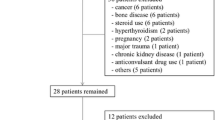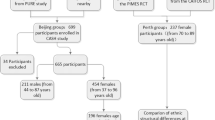Abstract.
Hip axis length (HAL) has been proposed as an independent predictor of hip fracture risk in Caucasian females. Femoral neck axis length (FNAL) is a similar measure of femoral geometry but does not include acetabular structures. The aim of this study was to examine the association between hip geometry, using FNAL, and hip fractures in elderly males and females in relation to other anthropometric data. The study group comprised 123 females (23 hip fracture patients and 100 age-matched controls) and 137 males (13 hip fracture patients, 65 age-matched controls and 59 current-height-matched controls). All subjects had femoral neck bone mineral density measured by dual-energy X-ray absorptiometry. From these scans, FNAL was measured as the linear distance from the base of the greater trochanter to the apex of the femoral head. FNAL was correlated significantly with current height (r = 0.47 and r = 0.56 for females and males respectively; p < 0.0001) and peak height (r = 0.45 and r = 0.57 for females and males respectively; p < 0.0001) in both sexes. In females, FNAL in the fracture patients (91.5 ± 5.4 mm, mean ± SD) was not significantly different from FNAL in controls (89.7 ± 5.4 mm; p = 0.2). Fracture patients had the same current height as controls and a trend towards a greater peak height (163 ± 6 cm vs 160 ± cm; p = 0.09). After adjusting FNAL for current or peak height there was no difference in FNAL between fracture patients and controls. In males, FNAL in the fracture patients (103.9 ± 3.9 mm) was not significantly different from that of age-matched controls (103.4 ± 6.3 mm; p = 0.79). Fracture patients had significantly lower current height (168 ± 6 cm) than the age-matched controls (174 ± 6 cm; p = 0..0008) but had the same peak height. When adjusted for peak height there were no significant differences between height of hip fracture patients (102.0 ± 4.9 cm), age-matched controls (102.1 ± 5.1 cm) and current-height-matched controls (102.6 ± 5.3 cm). Fracture patients had a significantly greater height loss (peak height minus current height) than either control group. In logistic regression analyses peak height in females and height loss in males but no FNAL were independent predictors of hip fracture. The greater height, FNAL and presumably HAL in male versus females is not associated with increased hip fracture risk. However, in this study of elderly males and females, peak height (females) and height loss (males) were independent risk factors for hip fracture. Moreover, FNAL appears to have limited utility in the prediction of hip fracture risk and any role of HAL in the prediction of hip fracture does not relate to its major component of femoral neck length.
Similar content being viewed by others
Author information
Authors and Affiliations
Additional information
Rights and permissions
About this article
Cite this article
Center, J., Nguyen, T., Pocock, N. et al. Femoral Neck Axis Length, Height Loss and Risk of Hip Fracture in Males and Females. Osteoporos Int 8, 75–81 (1998). https://doi.org/10.1007/s001980050051
Issue Date:
DOI: https://doi.org/10.1007/s001980050051




